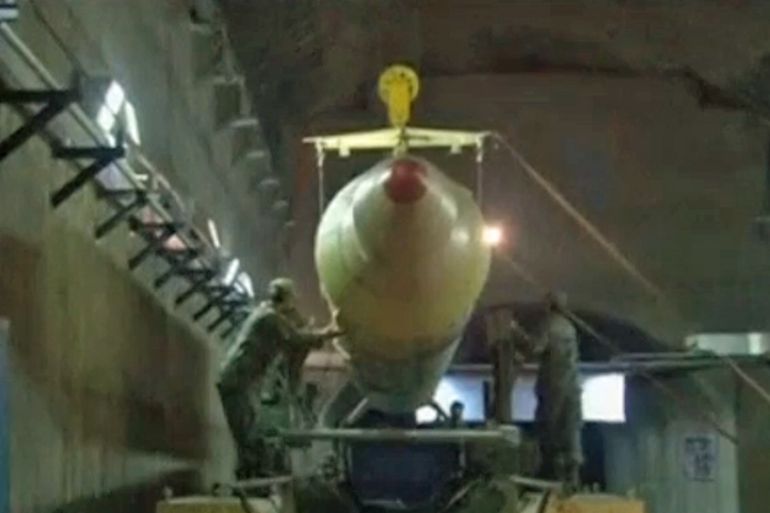Iran’s missiles: How big a threat to regional rivals?
What kind of a military impact could Iran’s ballistic missile arsenal have in the event of a potential conflict?

The recent launch of several medium-range ballistic missiles (MRBMs) by Iran has focused international attention on the Islamic Republic’s considerable ballistic missile arsenal – for years, an important factor in regional security concerns.
So how much of a threat are these weapons to Iran’s rivals in the Middle East?
Keep reading
list of 4 itemsRussia-Ukraine war: List of key events, day 790
Two military helicopters collide mid-air in Malaysia
Ten crew killed after two Malaysian Navy helicopters collide in midair
Ballistic missiles have significant military advantages over more traditional aircraft or cruise missiles when it comes to delivering explosives over long distances – as well as significant limitations.
READ MORE: Iran launches ballistic missiles during military drill
First used by Nazi Germany against British cities during the final years of the Second World War, ballistic missiles are launched vertically to an extremely high speed. After their rocket motors have burnt out, they follow a ballistic trajectory until they fall onto their targets.
The most obvious military advantage ballistic missiles possess is the extremely high speed at which their warheads fall onto their targets. This makes them extremely hard to intercept and give little warning time for an opponent.
Intercepting missiles
The longer the range of a missile, the higher it must arc upwards on its trajectory – and so the higher speed it picks up on its descent onto the target.
The Qadr H missiles launched by Iran on Tuesday have a range of around 2000km and a maximum speed of around Mach 14.
This makes intercepting them a very complex operation – even with specialist ballistic missile defence systems like the American Patriot PAC-3. It also limits the area defensive systems can cover.
The only systems able to reliably counter medium-range ballistic missiles are large and extremely costly. They include the Standard Missile 3 – used by the US Navy’s Aegis system – and the Terminal High Altitude Area Defence system, which has been procured by the United Arab Emirates (UAE) and Oman.
READ MORE: US ‘will act’ if Iran missile tests violated deal
As a result, they are deployed in limited numbers, even by the US, and could be saturated by a reasonable number of potential simultaneous Iranian launches.
It is reasonable to assume that if Iran were to launch a substantial proportion of its medium-range ballistic missile stocks at targets in Saudi Arabia or Israel, for example, the existing defence systems in the Gulf would not be able to shoot down all the incoming threats.
But, what would be the impact of the missiles on their potential targets?
Military impact ‘limited’
It is worth noting that accuracy is a fundamental limiting factor for ballistic missiles.
The most advanced Iranian MRBMs can reportedly achieve an accuracy of between 50m and 100m circular error probable – the radius within which half of the rounds fired would be expected to land.
This is sufficient to target cities and large military bases, such as airfields and oil installations, but not for hitting moving targets or individual buildings.
This is why ballistic missiles have traditionally been associated with nuclear, chemical or biological warheads, which do not require pinpoint accuracy to have devastating effects on targets.
READ MORE: Iran Supreme Leader endorses nuclear deal with caveats
However, with the nuclear deal appearing to hold for now, Iran insists that its ballistic missiles are armed with conventional explosive warheads.
This greatly limits the military impact that they could have in a potential confrontation with the Islamic Republic’s neighbours.
Destructive capacity

The warheads which are fitted to the various Shahab and Qadr series ballistic missiles are believed to be limited to between 700kg and 1000kg.
That translates to a reasonably powerful high-explosive (non-nuclear) warhead, roughly comparable to the heavy 2000lb-class laser and GPS guided bombs which have become the backbone of Western-made fighter bombers’ ground attack capabilities.
However, since each ballistic missile only carries a single 1000kg payload, whereas a fighter can carry multiple bombs and rockets, the impact of a conventional-warhead from a Qadr or Shahab missile would be less than the strike power of a single F-15E or F-16 fighter bomber.
The Qadr H can reportedly carry a multiple independently targetable re-entry vehicle (MIRV) warhead.
This enables multiple targets to be hit by the same missile but with smaller individual warheads. It also greatly complicates any attempt to shoot down the incoming threat by missile defence systems.
READ MORE: Iran’s Russian missile ‘intensify arms race’
However, the overall payload weight limit remains unchanged and so the destructive capacity of even a MIRVed Qadr H with conventional explosives is probably no greater than a Western strike fighter.
In the event of a conflict, Iran’s ballistic missile arsenal could almost certainly place warheads with nearly 1000kg of explosives on cities and military bases as far afield as Israel, despite the presence of ballistic missile defence systems in the region.
The military impact that they could have by disabling runways and facilities at key military bases in the UAE, Saudi Arabia, Qatar and even Israel would be inconvenient and costly – but would certainly not turn the tide of any military operation against Iran by the Gulf Cooperation Council, Israel or the US.
Without nuclear, chemical or biological warheads, the international community should view Iran’s ballistic missile capabilities for what they are – a potentially dangerous but not decisive or hugely effective conventional deterrent.
Justin Bronk is a Research Fellow in Military Sciences at the Royal United Services Institute.
The views expressed in this article are the author’s own and do not necessarily reflect Al Jazeera’s editorial policy.